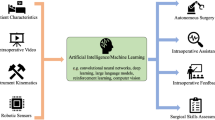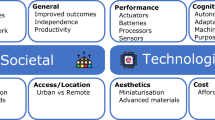Abstract
Background
The primary limitation of telesurgery is the communication latency. Accurate and detailed data are lacking to reveal the latency effects on surgical performance; furthermore, the maximum acceptable latency in telesurgery remains unclear.
Methods
Sixteen medical students performed an energy dissection exercise and a needle-driving exercise on the robotic simulator dV-Trainer®, and latencies varying between 0 and 1,000 ms with a 100-ms interval were randomly and blindly presented. Task completion time, instrument motion, and errors were automatically recorded. The difficulty, security, precision, and fluidity of manipulation were self-scored by subjects between 0 and 4 (0 the best, 2 moderate, and 4 the worst).
Results
Task completion time, motion, and errors increased gradually as latency increased. An exponential regression was fit to the mean times and motions (R 2 > 0.98). Subjective scorings of the four items were similar. The mean scores were less than 1 at delays ≤200 ms, then increased from 1 to 2 at 300–700 ms, and finally approached 3 at delays above. In both exercises, latencies ≤300 ms were judged to be safe by all and 400–500 ms were accepted by 66–75 % of subjects. Less than 20 % of subjects accepted delays ≥800 ms.
Conclusions
The surgical performance deteriorates in an exponential way as the latency increases. The delay impact on instrument manipulation is mild at 0–200 ms, then increases from small to large at 300–700 ms, and finally becomes very large at 800–1,000 ms. Latencies ≤200 ms are ideal for telesurgery; 300 ms is also suitable; 400–500 ms may be acceptable but are already tiring; and 600–700 ms are difficult to deal with and only acceptable for low risk and simple procedures. Surgery is quite difficult at 800–1,000 ms, telementoring would be a better choice in this case.






Similar content being viewed by others
Reference
Haidegger T, Sándor J, Benyó Z (2010) Surgery in space: the future of robotic telesurgery. Surg Endosc 25:681–690. doi:10.1007/s00464-010-1243-3
Marescaux J, Leroy J, Gagner M, Rubino F, Mutter D, Vix M, Butner SE, Smith MK (2001) Transatlantic robot-assisted telesurgery. Nature 413:379–380. doi:10.1038/35096636
Anvari M, McKinley C, Stein H (2005) Establishment of the world’s first telerobotic remote surgical service. Ann Surg 241:460–464. doi:10.1097/01.sla.0000154456.69815.ee
Sterbis JR, Hanly EJ, Herman BC, Marohn MR, Broderick TJ, Shih SP, Harnett B, Doarn C, Schenkman NS (2008) Transcontinental telesurgical nephrectomy using the da Vinci robot in a porcine model. Urology 71:971–973
Rayman R, Croome K, Galbraith N, McClure R, Morady R, Peterson S, Smith S, Subotic V, Van Wynsberghe A, Patel R, Primak S (2007) Robotic telesurgery: a real-world comparison of ground- and satellite-based internet performance. Int J Med Robot 3:111–116. doi:10.1002/rcs.133
Nguan CY, Morady R, Wang C, Harrison D, Browning D, Rayman R, Luke PPW (2008) Robotic pyeloplasty using internet protocol and satellite network-based telesurgery. Int J Med Robot 4:10–14. doi:10.1002/rcs.173
Nguan C, Miller B, Patel R, Luke PP, Schlachta CM (2008) Pre-clinical remote telesurgery trial of a da Vinci telesurgery prototype. Int J Med Robot 4:304–309. doi:10.1002/rcs.210
Lum MJH, Friedman DCW, Sankaranarayanan G, King H, Fodero K, Leuschke R, Hannaford B, Rosen J, Sinanan MN (2009) The RAVEN: design and validation of a telesurgery system. Int J Robot Res 28:1183–1197. doi:10.1177/0278364909101795
Arata J, Takahashi H, Pitakwatchara P, Warisawa S, Konishi K, Tanoue K, Ieiri S, Shimizu S, Nakashima N, Okamura K, Kim YS, Kim SM, Hahm JS, Hashizume M, Mitsuishi M (2006) A remote surgery experiment between Japan-Korea using the minimally invasive surgical system. In: Proceedings 2006 IEEE International Conference on Robotics and Automation 2006 ICRA 2006, pp 257–262
Arata J, Takahashi H, Pitakwatchara P, Warisawa S, Tanoue K, Konishi K, Ieiri S, Shimizu S, Nakashima N, Okamura K, Fujino Y, Ueda Y, Chotiwan P, Mitsuishi M, Hashizume M (2007) A remote surgery experiment between Japan and Thailand over Internet using a low latency CODEC system. In: IEEE International Conference on Robotics and Automation, pp 953–959
Choi J, Park JW, Kim DJ, Shin J, Park CY, Lee JC, Jo YH (2012) Lapabot: a compact telesurgical robot system for minimally invasive surgery: part I. system description. Minim Invasive Ther Allied Technol 21:188–194. doi:10.3109/13645706.2011.579979
Park JW, Lee DH, Kim YW, Lee BH, Jo YH (2012) Lapabot: a compact telesurgical robot system for minimally invasive surgery: Part II. Telesurgery evaluation. Minim Invasive Ther Allied Technol 21:195–200. doi:10.3109/13645706.2011.579978
Kim KY, Song H-S, Suh J-W, Lee J-J (2013) A novel surgical manipulator with workspace-conversion ability for telesurgery. IEEEASME Trans Mechatron 18:200–211. doi:10.1109/TMECH.2011.2164929
Marescaux J, Leroy J, Rubino F, Smith M, Vix M, Simone M, Mutter D (2002) Transcontinental robot-assisted remote telesurgery: feasibility and potential applications. Ann Surg 235:487–492
Lum MJH, Rosen J, Lendvay TS, Sinanan MN, Hannaford B (2009) Effect of time delay on telesurgical performance. In: Robotics and Automation 2009 ICRA09 IEEE International Conference pp 4246–4252
Rayman R, Croome K, Galbraith N, McClure R, Morady R, Peterson S, Smith S, Subotic V, Van Wynsberghe A, Primak S (2006) Long-distance robotic telesurgery: a feasibility study for care in remote environments. Int J Med Robot 2:216–224. doi:10.1002/rcs.99
Anvari M, Broderick T, Stein H, Chapman T, Ghodoussi M, Birch DW, McKinley C, Trudeau P, Dutta S, Goldsmith CH (2005) The impact of latency on surgical precision and task completion during robotic-assisted remote telepresence surgery. Comput Aided Surg Off J Int Soc Comput Aided Surg 10:93–99. doi:10.3109/10929080500228654
Kim T, Zimmerman PM, Wade MJ, Weiss CA (2005) The effect of delayed visual feedback on telerobotic surgery. Surg Endosc 19:683–686
Perez M, Quiaios F, Andrivon P, Husson D, Dufaut M, Felblinger J, Hubert J (2007) Paradigms and experimental set-up for the determination of the acceptable delay in Telesurgery. 29th Annual International Conference of the IEEE Engineering in Medicine and Biology Society2007 EMBS 2007, pp 453–456
Perrenot C, Perez M, Tran N, Jehl JP, Felblinger J, Bresler L, Hubert J (2012) The virtual reality simulator dV-Trainer® is a valid assessment tool for robotic surgical skills. Surg Endosc 26:1–7
Lee JY, Mucksavage P, Kerbl DC, Huynh VB, Etafy M, McDougall EM (2012) Validation study of a virtual reality robotic simulator—role as an assessment tool? J Urol 187:998–1002. doi:10.1016/j.juro.2011.10.160
Butner SE, Ghodoussi M (2003) Transforming a surgical robot for human telesurgery. Robot Autom IEEE Trans 19:818–824
Acknowledgments
The authors would like to thank l’Ecole de Chirurgie de Nancy and all the participants in this study. We would also like acknowledge Roger D. Smith for his assistance in the English modification and Anou Sewonu for his help in the statistics. The first author is supported by the fellowship provided by the China Scholarship Council for the studies at Lorraine University.
Disclosures
Dr. Xu, Dr. Perez, Dr. Yang, Dr. Perrenot, Dr. Felblinger, and Dr. Hubert have no conflicts of interest or financial ties to disclose.
Author information
Authors and Affiliations
Corresponding author
Rights and permissions
About this article
Cite this article
Xu, S., Perez, M., Yang, K. et al. Determination of the latency effects on surgical performance and the acceptable latency levels in telesurgery using the dV-Trainer® simulator. Surg Endosc 28, 2569–2576 (2014). https://doi.org/10.1007/s00464-014-3504-z
Received:
Accepted:
Published:
Issue Date:
DOI: https://doi.org/10.1007/s00464-014-3504-z




